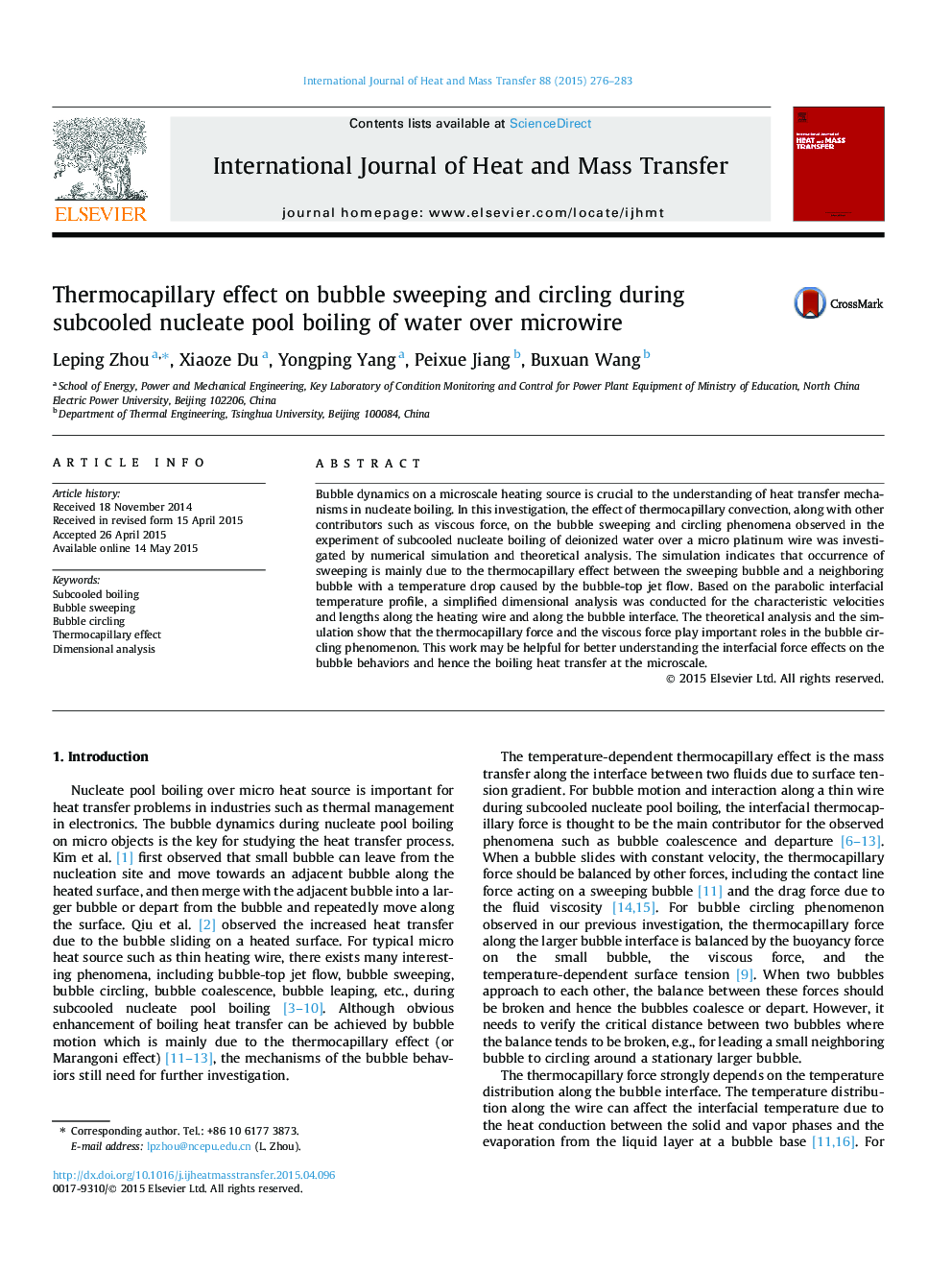| کد مقاله | کد نشریه | سال انتشار | مقاله انگلیسی | نسخه تمام متن |
|---|---|---|---|---|
| 657022 | 1458054 | 2015 | 8 صفحه PDF | دانلود رایگان |
عنوان انگلیسی مقاله ISI
Thermocapillary effect on bubble sweeping and circling during subcooled nucleate pool boiling of water over microwire
ترجمه فارسی عنوان
اثر ترموکاپیلی بر جابجایی حباب و چرخاندن آن در طی فرایند غوطه ور شدن هسته ی هسته ای
دانلود مقاله + سفارش ترجمه
دانلود مقاله ISI انگلیسی
رایگان برای ایرانیان
کلمات کلیدی
جوش بریزید حباب جاروبرقی، حفر حباب، اثر ترموکاپیلی، تجزیه و تحلیل ابعادی،
ترجمه چکیده
دینامیک حباب بر روی یک منبع حرارت گرمای میکروسکوپ برای درک مکانیزم انتقال حرارت در جوشش هسته ای بسیار مهم است. در این تحقیق اثر کنجکاوی حرارتی با همکاری دیگران مانند نیروی چسبناک بر روی پدیده حباب و حادثه غرقابی مشاهده شده در آزمایش جوشکاری نوکلئوتید زیر آب خنثی شده روی سیم میکرو پلاتین با استفاده از شبیه سازی عددی و تجزیه و تحلیل نظری . شبیه سازی نشان می دهد که وقوع جابجایی عمدتا به دلیل اثر ترموکاپیلیال بین حباب در حال جابجایی و یک حباب همسایه با کاهش دما ناشی از جت جریان بالای حباب است. براساس مشخصات دما مرزی پارابولی، برای اندازهگیری سرعت و طول مشخصه در امتداد گرمایی و در طول رابط حباب، یک تحلیل ساده ساده انجام شد. تجزیه و تحلیل نظری و شبیه سازی نشان می دهد که نیروی ترموکاپیلیال و نیروی چسبنده نقش مهمی در پدیده چرخاندن حباب بازی می کنند. این کار ممکن است برای درک بهتر اثرات نیروی موازی در رفتار حباب و از این رو انتقال حرارت جوش در محدوده میکروسکوپی مفید باشد.
موضوعات مرتبط
مهندسی و علوم پایه
مهندسی شیمی
جریان سیال و فرایندهای انتقال
چکیده انگلیسی
Bubble dynamics on a microscale heating source is crucial to the understanding of heat transfer mechanisms in nucleate boiling. In this investigation, the effect of thermocapillary convection, along with other contributors such as viscous force, on the bubble sweeping and circling phenomena observed in the experiment of subcooled nucleate boiling of deionized water over a micro platinum wire was investigated by numerical simulation and theoretical analysis. The simulation indicates that occurrence of sweeping is mainly due to the thermocapillary effect between the sweeping bubble and a neighboring bubble with a temperature drop caused by the bubble-top jet flow. Based on the parabolic interfacial temperature profile, a simplified dimensional analysis was conducted for the characteristic velocities and lengths along the heating wire and along the bubble interface. The theoretical analysis and the simulation show that the thermocapillary force and the viscous force play important roles in the bubble circling phenomenon. This work may be helpful for better understanding the interfacial force effects on the bubble behaviors and hence the boiling heat transfer at the microscale.
ناشر
Database: Elsevier - ScienceDirect (ساینس دایرکت)
Journal: International Journal of Heat and Mass Transfer - Volume 88, September 2015, Pages 276-283
Journal: International Journal of Heat and Mass Transfer - Volume 88, September 2015, Pages 276-283
نویسندگان
Leping Zhou, Xiaoze Du, Yongping Yang, Peixue Jiang, Buxuan Wang,
